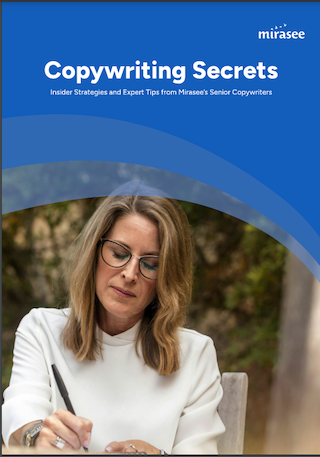15 Copywriting Tips That’ll Captivate Your Audience
Willy Wood
You have great products and services. You have a killer offer. You deliver over-the-top value.
But you’re still not getting the level of sales you want. What gives?
More than likely, it’s your copy.
When it comes down to it, no matter how good your business is, if you don’t communicate that value clearly and persuasively, people won’t buy.
As a content creator, you have to make every word count. Every. Single. Word.
And that’s what we’re going to show you how to do. In this article, we’ll share 15 copywriting tips that will help you kick your copy into high gear.
You’ll learn:
- How to create copy that engages your audience.
- Techniques to make your writing more compelling and persuasive.
- Strategies that drive your reader down the page and almost force them to hit that “buy” button.
So, are you ready? Let’s dive into these 15 transformative copywriting tips to elevate your skills and captivate your audience.
15 Copywriting Tips to Captivate Readers
Mastering the art of copywriting is key to capturing the attention and interest of your audience and convincing them to take action.
But if you don’t consider yourself a master copywriter, don’t stress about it. Great copywriters aren’t born, they’re made. With good strategies and a little practice, you can learn to be an excellent copywriter.
Below you’ll find 15 powerful tips to enhance your copywriting skills and engage your readers more effectively. Learn these strategies and put them into practice each time you sit down to crank out a new piece of copy. Before long, people will be calling you a master copywriter!
1. Write With a Clear Objective in Mind
The goal of all copywriting is to get your readers to take some type of action, usually immediately.
So, before you write a single word, ask yourself what action you want your readers to take as a result of reading your copy. Whether it’s subscribing to a newsletter, purchasing a product, or engaging with your content, your writing should be focused and directed towards that single goal.
For example, take something as simple as a social media post. Even though social posts tend to be short, there are many types of social posts and each type has a specific goal.
- Your goal might be engagement, in which case you’ll be trying to get as many comments on your post as possible. To achieve this, you’ll probably ask your readers a provocative question and encourage them to reply.
- On the other hand, your goal might be reach, meaning that you’re trying to get as many shares and reshares as possible to get your content in front of new people. With this goal in mind, you’ll probably look to create a meme with viral potential and then play on the egos of your followers so that they can feel smart or cutting edge by sharing what you’ve written.
- Or your goal might be conversions, in which case you’ll need to write your post using persuasive language followed by a call to action and a link to your website, or landing page.
It really comes down to clarity. Clarity is king in effective copywriting. So, before you even begin writing, clearly define your objective and write to achieve that objective, leaving out anything that could distract from that single purpose.
For example, in the following LinkedIn post, business development guru Marie Forleo wants to create engagement. So she makes a couple of bold statements then gives a clear call to action to her followers:

2. Follow a Proven Copywriting Formula
Adopting a proven formula can significantly improve the effectiveness of your copy while saving you writing time.
Formulas like AIDA (Attention, Interest, Desire, Action) or PAS (Problem, Agitate, Solution) provide a structured approach to writing. They guide you to first grab the reader’s attention, then build interest and desire, and finally prompt them to take action. Using such frameworks ensures your copy flows logically and maintains the reader’s engagement throughout.
These formulas can be used on a large scale (think multi-page sales letters) or on a small scale (think Google ads) and everything in between. Let’s look at a shortish example of the PAS formula in action from the website of the cat food company, Smalls:

In this example, the problem (P) is implied in the headline: some cat foods add a bunch of nonessential filler ingredients–and you don’t want that for your little fur baby.
The copy below the headline then agitates (A) the problem, expanding on it to the point that the reader feels compelled to take action to solve the problem. Here, the copy talks about the ingredients often found in cat food that are either useless or even harmful.
Finally, the copy offers the solution (S) to the problem: Smalls’ ultra-high protein cat food with no fillers. It then finishes off with a button that includes a call to action: “explore human-grade fresh.”
Another big benefit of using a formula as a starting point for your copy is that it gets you past that awkward, staring-at-a-blank-page (or screen) period. With a formula, you just start filling in the framework and you’re off and running. Once you have the basic elements filled in, you can start refining your draft.
If you’re not familiar with copywriting formulas, check out our blog post on the topic, “10 Tried-and-Tested Copywriting Formulas (& Examples).”
3. Start With a Problem or Statement that Your Audience Can Relate To
Your copy should begin with a relatable problem or statement that resonates with your audience. This approach immediately grabs their attention, as it speaks directly to their challenges.
There are two interconnected elements here:
- A problem…
- That your audience can relate to
The key here is to know your audience in great depth. If you know who your target audience is, what challenges they’re dealing with on a daily basis (their pain points), and the kind of solutions they’re looking for, you have a good chance of grabbing their attention and holding it throughout your copy.
If you’ve developed an ideal customer avatar, you should be able to find all the information you need there.
By acknowledging your audience’s pain points or aspirations at the outset, you establish an immediate connection and lay the groundwork for presenting your product or service as the solution they’ve been seeking, meaning that you significantly raise the chances that your copy will convert.
For more information about developing a deep understanding of your audience, see our blog post about creating a customer profile.
4. Show How Your Products or Services Transform People’s Lives
It’s always best to keep in mind that your readers aren’t necessarily interested in the details of your product or service in itself. What they’re really interested in is how the product or service will make their lives better.
So, what does that mean for your copywriting?
We’ve already discussed that understanding your prospect’s problem and articulating that problem early on in your copy is one of the best ways to hook your reader. But then you have to transition from discussing the problem to showing how your product or service solves that problem.
So, instead of just listing product features, focus on the real-life benefits and changes your audience can expect from using the product. The goal should be to demonstrate the transformation that your products or services bring about in people’s lives.
An effective way to do this is to use testimonials or case studies to paint a vivid picture of the positive impact your offering has made in the lives of your customers. This approach helps prospects visualize and relate to the value they will receive, making your copy more persuasive and impactful.
For example, Crazy Egg, which provides businesses with website optimization tools, lets their satisfied customers talk about the transformations they experienced in their businesses through Crazy Egg’s services. Notice how, even before you click through to the full case studies, they lay out the benefits these customers received in the blurbs under “Case Study”:

5. Use Power Words to Evoke Emotion
Power words are a copywriter’s secret weapon. These emotionally charged words can significantly impact your audience, evoking feelings that drive action.
Words like “amazing,” “unbelievable,” “exclusive,” or “limited-time” can create excitement, urgency, or a sense of belonging. Integrating such words into your copy strategically can make your message more compelling and memorable.
Imagine two versions of a promotional email for a fitness course. The first starts with, “Our course helps you get fit.” The second begins, “Unleash your potential and conquer your fitness goals with our course!” The second version uses power words like “unleash” and “conquer,” evoking a sense of empowerment and action, making it more emotionally engaging and likely to prompt a response.
Case in point: Hoka shoes. Most of the pages on their website offer the standard online store content you’d expect–pages for men’s shoes, women’s shoes, kids’ shoes, apparel–with photos of the products, features, prices, etc.
But if you’re checking out Hoka for the first time, you’re likely to go to their About page to see what the company’s all about before looking at specific products. And if you do that, you’ll find copy that reads almost like a poem, chock full of power words. Here are two sections of that copy:


Words such as “unwavering belief,” “poured your heart into a wild idea,” “fly down mountains,” “movement is good magic,” and “gear up” engage the reader and get them excited to check out Hoka’s products.
And if you’re thinking, “I wish I had a list of these kinds of power words handy when I write my copy,” no worries. OptinMonster’s got you covered with their list of over 700 copywriting power words. You’ll never be left wanting for a power word when you need one!
6. Convey Empathy for the Reader
There’s an old adage in copywriting: people buy from people they know, like, and trust.
But people don’t begin to like you and trust you unless you first reach out to them and show that you care.
Empathy is a powerful tool in copywriting.
Showing your readers that you understand their struggles, fears, and desires is just the first step. You must also show them that you’re not only interested in selling them a product or service, but you’re also interested in providing a solution that genuinely improves their lives. And you do this by using empathetic language in your copy.
This approach builds trust and strengthens the connection between your brand and your audience, making your message more relatable and persuasive.
Another way to build trust is transparency. For example, instead of hiding their production processes, natural cosmetics brand LUSH puts out regular YouTube videos showing exactly how they make their products, like their Unicorn Horn Bubble Bar (below).
This allows customers to see that they truly care about using the best natural ingredients, which, in turn, shows that they care about their customers’ experience with their products. That’s empathy. And empathy sells.

7. Paint a Picture in Your Reader’s Minds
The more you can engage your readers in your copy, the longer they’ll keep reading. And the longer they keep reading, the more of your persuasive argument they take in, the closer they get to your call to action, and the more likely they are to respond to that CTA when they get there.
So, how do you keep them reading? We’ve mentioned several ways already–address a problem they have, talk about the transformation your product or service provides, show empathy.
But you have more tools in your toolbelt when it comes to keeping your readers engaged. One such tool is to use vivid, descriptive language to create mental images for your readers. This technique, often referred to as “painting a picture,” helps to immerse the reader in the experience you’re describing.
Whether it’s the feeling of success, the comfort of using your product, or the excitement of achieving a goal, descriptive language makes your copy more engaging and helps your audience to see the real-world application and benefits of what you’re offering.
Let’s use LUSH again as an example. Here’s the kind of copy they use when describing their products–in this case, their Snow Fairy Shower Gel:

Here, LUSH uses the senses of sight (fluffy bubbles, shimmering luster, sparkly, pink), smell (bubblegum and sweet vanilla fragrance, candy-scented), and touch (lathering, fluffy, keeps skin feeling soft) to vividly describe the experience of using the product.
8. Raise Open-Ended Questions
Yet another copywriting trick for keeping readers engaged involves incorporating open-ended questions into your copy to engage your readers’ minds.
When you ask your reader a question, they feel compelled to answer the question in their own minds. Questions like “What would you do if…?” or “Have you ever wondered…?” encourage readers to reflect on their own experiences and aspirations.
This interaction not only keeps them engaged, but also helps them personalize the message, making your copy more impactful and thought-provoking.
Open-ended questions can be used in a variety of ways in copywriting. For example, you can use them:
- In surveys
- As prompts to generate testimonials
- In customer interviews
- In social media posts
- In emails
- And many more
For example, entrepreneur and Shark Tank panelist Daymond John posted the following survey on LinkedIn. This survey is a mixture of open and closed questions.
The open question is “what aspects of your business are you aiming to supercharge in the next quarter?” He then gives four options (the closed question part) to choose from. People’s answers to that multiple choice question gives him some feedback on people’s biggest goals for their businesses.
However, by having the open-ended question just before the multiple choice options, he leaves the question open to other responses–and many people left other answers to the question in the comments. Which gives him even more feedback. Score!

9. Convey Meaning in as Few Sentences as Possible
Brevity is a virtue in effective copywriting. Aim to convey your message in as few sentences as possible.
This doesn’t mean cutting out essential details, but rather being concise. In a world where attention spans are short, delivering a clear, succinct message can make your copy more digestible and compelling. Each sentence should serve a purpose, whether it’s to inform, persuade, or evoke an emotional response.
For example, BODi (formerly BeachBody) could have spent an entire page digging into the motivations of people who are trying to get into (or back into) an exercise routine, talking about the different features of their BODi Blocks fitness program and why it’s the best approach, and trying to convince the reader to take them up on their discounted offer to get started.
But they don’t. Instead, they get right to the point and cover all of these points in just a few lines of copy:

10. Use Strong Action Verbs
Strong action verbs breathe life into your copy, making it more dynamic and powerful.
Words like “achieve,” “transform,” “overcome,” and “build” can significantly increase the impact of your message. These verbs help create a sense of motion and progress, which can be very motivating for your readers.
By choosing your verbs carefully, you can make your copy more energetic and inspiring.
Want to take a deeper dive into the topic of active verbs, the difference between active voice and passive voice, and ways to spot passive voice in your writing (teaser: it involves zombies)? Hop on over to this informative blog post on Crazy Egg.
11. Consider How Your Words Look on the Page
The visual layout of your copy matters just as much as the words themselves.
Use short paragraphs, bullet points, and varied sentence lengths to make your text more readable and visually appealing. Large blocks of text can be intimidating and may deter readers.
A well-structured layout not only makes your content more digestible, but also guides the reader’s eye through your message, enhancing overall engagement.
Take the copy on digital marketer Frank Kern’s About page, for example. He combines short sections of text with images and lots of white space to guide your eye down the page with virtually no friction. Combine those elements with an engaging brand voice, and you can see why he’s one of the top digital marketers in the world.
Here are just two screenshots from his About page to show you what we mean:
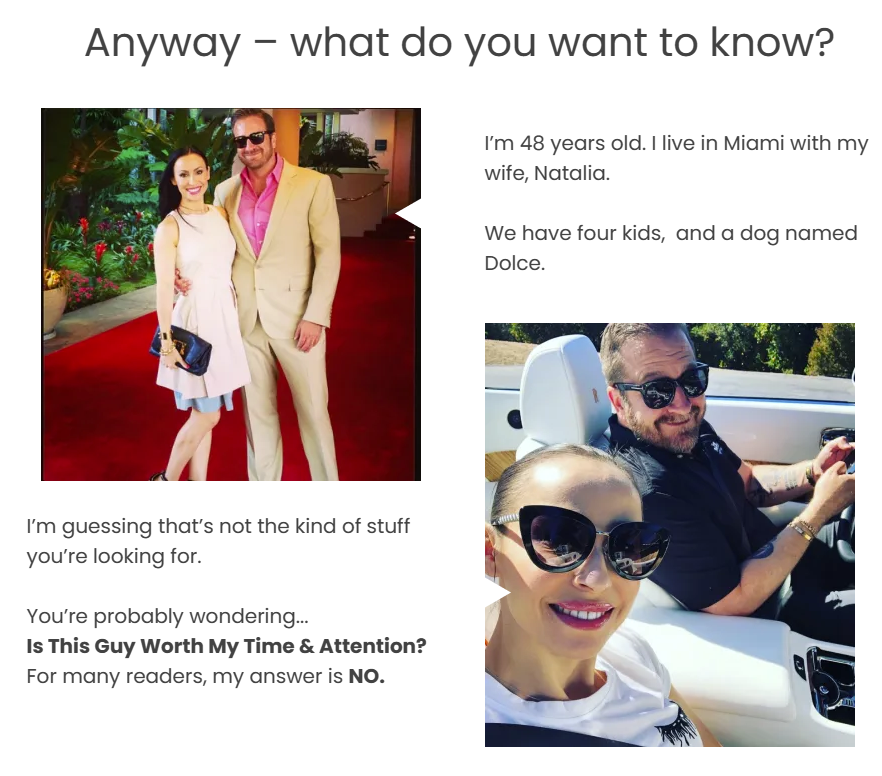
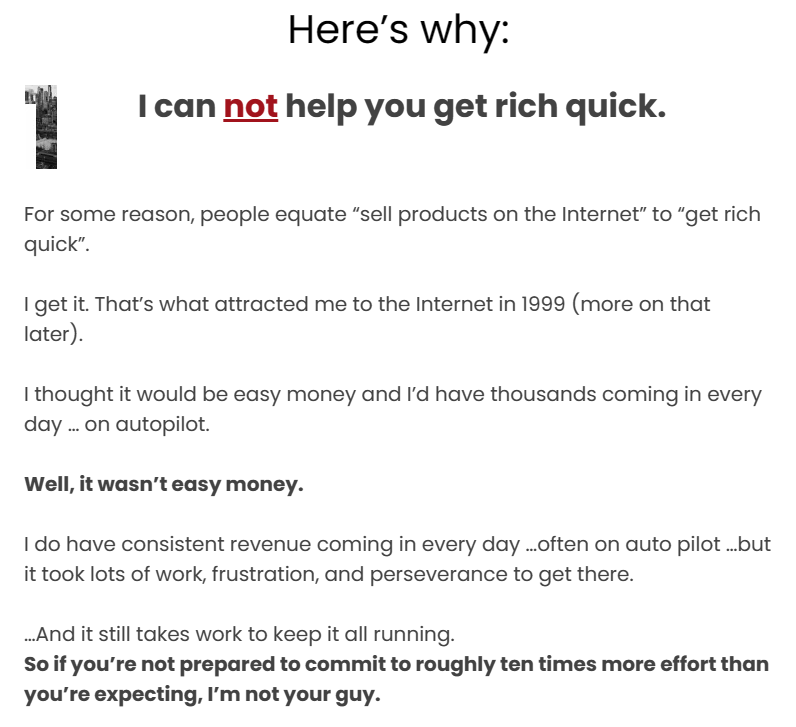
Makes you want to keep reading to learn more, right? That’s the point!
12. Avoid Writing in the First Person
While writing in the first person can sometimes create a personal touch, it’s often more effective in copywriting to focus on the reader.
Use second-person pronouns like “you” and “your” to directly address and engage your audience. This approach makes your copy more reader-centric, emphasizing their needs and how they can benefit from what you’re offering, thereby making your message more relatable and persuasive.
The one main exception to this tip is when your brand is built around your personal story or personality. In this case, don’t avoid using “I” to refer to yourself, but still speak to your audience in second person, addressing them as “you.” This combination gives the effect of chatting face-to-face with your reader.
Case in point: look back at the Frank Kern example in the previous section. His business is definitely built around his personality as much as his marketing strategies. That’s why his website is frankkern.com, and it’s also why he uses the first person/second person combination in his copywriting.
13. Create a Sense of Urgency
Creating a sense of urgency can motivate readers to act promptly. When used judiciously, this technique can effectively encourage readers to take immediate action.
Use phrases like “limited time offer,” “exclusive deal ends soon,” or “join the few who…” to instill a fear of missing out (FOMO).
Do, however, use urgency authentically. Overusing urgency or using false urgency can erode trust with your audience. And when you lose a customer’s trust, you lose the customer.
Consider two different calls to action for a limited-time discount on a marketing seminar. One says, “Join our seminar if you’re interested in improving your marketing skills.” The other states, “Hurry! Only a few seats left to transform your marketing prowess – register now!”
The second CTA creates urgency with phrases like “Hurry” and “Only a few seats left,” prompting immediate action compared to the more passive first option.
In the following pop-up ad on the Minimewear website, they pull multiple urgency triggers to get you to click to learn more about their sale items–”Black Friday Sale” (implies that sale ends at the end of the day), “Don’t Miss It!” “Hurry, sale starts on November 9, 2023”:
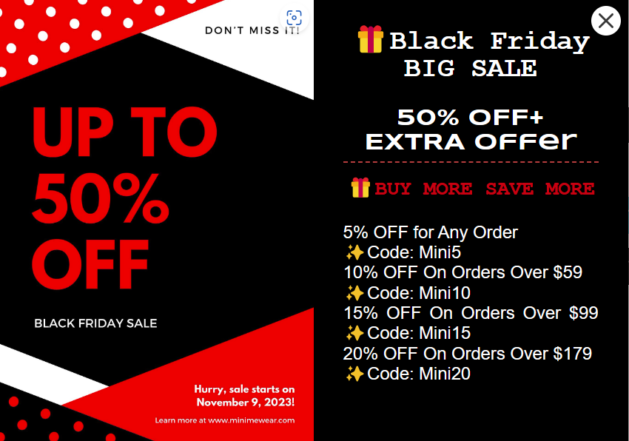
14. Write for People, Not for Google
While SEO is important, your primary focus should be on writing for people.
Engaging, valuable content resonates more with readers than keyword-stuffed text. Remember, it’s real people who read, share, and act on your content, not search engines. So always consider first the “searcher intent” of your audience and make sure that what they find fits that intent perfectly.
Striking the right balance between SEO and natural, compelling writing is key to creating copy that not only ranks well but also genuinely connects with your audience.
For example, imagine an environmentally conscious shopper looking for environmentally friendly clothing products. What would they find if they searched for “best sustainable clothing brands”? Answer: they would find Toad&Co. Sustainable Clothing.
Here’s their ad, currently sitting in the #1 position on Google:
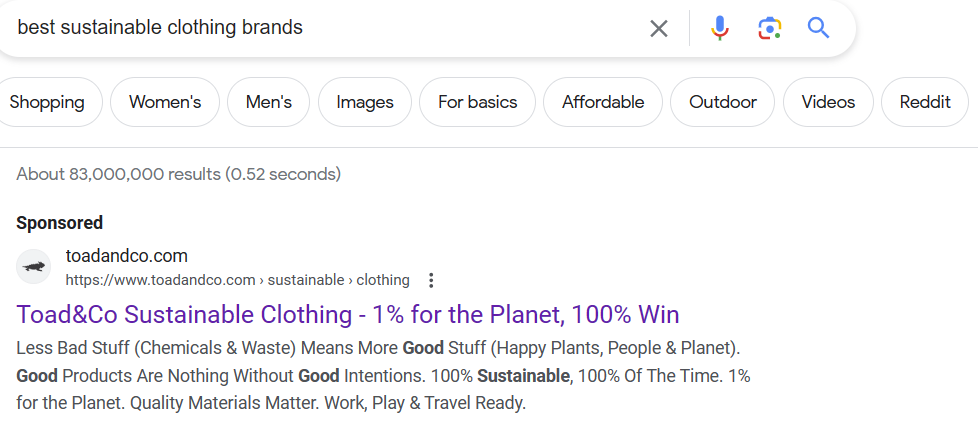
As you can see, the copy speaks strongly to the environmentally-conscious shopper.
And here’s what they’ll find when they follow the ad through to the website:

Now that’s copy that speaks to people (or at least a certain kind of person) and at the same time performs well in the search engines.
15. Leverage Negative CTAs Instead of Positive Ones
Sometimes, using negative calls to action can be more effective than using positive ones. This approach plays on the fear of missing out (FOMO) and can be a powerful motivator.
Phrases like “Don’t miss out on this opportunity” or “Avoid common mistakes by…” prompt action by highlighting what the reader stands to lose if they don’t engage. This reverse psychology can be a subtle yet effective way to encourage readers to take immediate action.
Here’s an ad on The Home Depot’s site. It combines two urgency elements: “Today Only!” and a countdown timer (“Ends in 11 hrs 37 mins 22 secs”), then ends with a CTA that’s subtle, but a negative CTA nevertheless. The specials being advertised are “today’s” specials, which implies that they’ll be gone tomorrow.
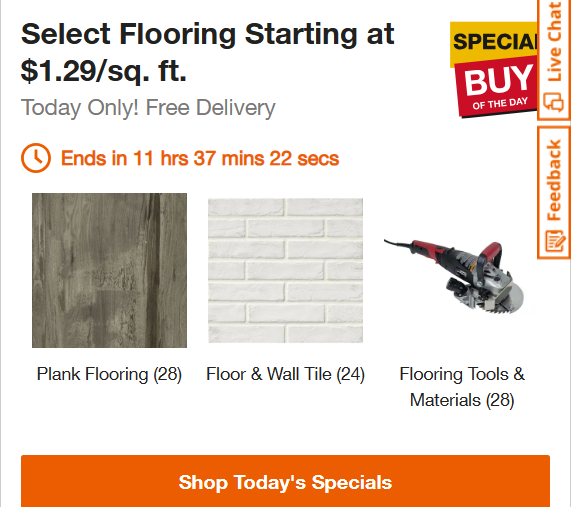
Take Your Skills to the Next Level with These Copywriting Tips
In mastering these 15 copywriting tips, you’re well on your way to captivating your audience with every piece of content you create.
From writing with a clear objective to leveraging negative CTAs, each of these tips is designed to make your copy more engaging, persuasive, and effective.
Remember, great copywriters are made, not born. The key to great copywriting is continuous learning and adaptation. Keep refining your skills and watch as your words transform into powerful tools that resonate with and inspire your audience.
Elevate Your Copywriting Game!
Discover winning strategies and insider tips for writing words that sell - from Mirasee’s very own expert copywriting team!